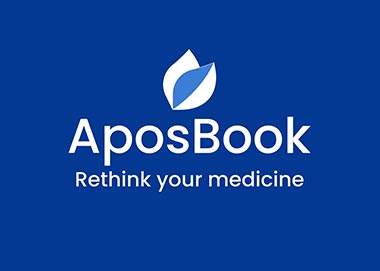Ready to leave?
Oops ! Condition name you have entered is invalid.
You are now leaving Aposbook.com and going to an external site managed by another organization.
Please confirm your email address and try to login again.
This account has been deleted. do you want to restore it?

Validate your email
A verification link will be sent to within the next 2 minutes. Please click it to validate your e mail.
*If you didn't get the link, please check your spam folder
Welcome to Aposbook,
As a registered user, you can benefit from the various free tools and services that we provide.
All you need to do is log in to start discussing with others, interacting, asking questions, and sharing your point of view about the various topics.
You can also write reviews and testimonials about any natural solution you have tried and share your experience. Your feedback can be very helpful.
If you are a health expert, you can add information about any topic or suggest text edit. You can also publish content, including articles and videos, about any topic from the related library section.
Together we can help.
The Aposbook Team
Forgot Password?
A validation link will be sent to you by email. Please confirm your address to log in
*If you didn't get the link, please check your spam folder
Please log in to use this feature
Your account has been suspended because you have violated our code of conduct. If you think this was a mistake, you can contact us by email at: support@aposbook.com "Contact us" form.
Success! Thank you for your feedback. Your contribution can make a difference. Together we can help each other.


Diseases and conditions
Disc Herniation
Disc Herniation: Causes, Prevention, Natural Treatments
Complete Guide to Disc Herniation

Disc bulge
A disc bulge precedes the state of herniation. It occurs because of high pressure in the nucleus cavity ...
A disc bulge precedes the state of herniation. It occurs because of high pressure in the nucleus cavity.
This results in a slight irregular curvature in the annulus area to compensate for the increasing pressure in the nucleus.

Extrusion
A disc extrusion is the second stage of a disc herniation. It occurs because of a tear in ...
A disc extrusion is the second stage of a disc herniation. It occurs because of a tear in the annular region of the disc, associated with the expulsion of the nucleus outside its cavity.
However, the disc extrusion remains attached to the intervertebral disc.

Protrusion
A disc protrusion is the first stage of a disc herniation. It occurs because of a tear in ...
A disc protrusion is the first stage of a disc herniation. It occurs because of a tear in the annular region of the disc, resulting in the protrusion of the gel-filled interior, but it does not escape its original cavity.
Individuals can feel the disc pressing against the nerves. However, the spinal disc and the associated ligaments remain intact.

Sequestered fragment
A sequestered fragment is the final stage of a disc herniation. It occurs because of a tear in the ...
A sequestered fragment is the final stage of a disc herniation. It occurs because of a tear in the annular region of the disc. The nucleus is expelled outside of its cavity and loses its continuity with the disc.
The nucleus fragment can migrate to other areas of the spinal cord, causing back pain and affecting the normal functions of the spinal cord.
What is Disc Herniation
The human body is centered around a prolonged structure made of several bone formations (vertebrae) and discs composed of fibrous bands and a gel-filled interior (intervertebral discs) called the spinal column.
Although made of bone, this mechanism supporting both structures, bones and discs, allows the spinal column to retain a certain range of flexibility. This allows humans to bend their bodies while protecting themselves from external trauma and bone friction.
Meanwhile, the intervertebral discs act like ...
What is Disc Herniation
The human body is centered around a prolonged structure made of several bone formations (vertebrae) and discs composed of fibrous bands and a gel-filled interior (intervertebral discs) called the spinal column.
Although made of bone, this mechanism supporting both structures, bones and discs, allows the spinal column to retain a certain range of flexibility. This allows humans to bend their bodies while protecting themselves from external trauma and bone friction.
Meanwhile, the intervertebral discs act like a jelly donut, with a softer center (called the nucleus) encased within a tougher exterior (called the annulus).
A spinal disc herniation occurs when there is a tear in the annulus, resulting in the protrusion of the gel-filled interior. The pain is either the result of a tear in the annular region or a disc pressing on the spinal nerves that run alongside the spinal column.
The symptoms of a herniated disc can be sometimes minor and easy to ignore. However, sometimes they become severe and incapacitating especially if the disc starts pressing on the spinal nerves.
A herniated disc can affect various regions of the spinal column and is either cervical, thoracic, lumbar, or intradural. Typically, a lumbar herniation affects the buttocks, calves, and legs, while cervical herniation affects the arms. People may have different symptoms and prognosis depending on what vertebrae are affected.
Disc Herniation History
As far back as 400 B.C., Hippocrates, known to be the father of medicine, observed the relationship between “sciatica, an antalgic posture, and claudication.” To treat sciatica or back pain caused by the compression of the sciatic nerve, he prescribed rest, massage, heat, dietary changes, and music therapy.
In 1857, the German physician Dr. Rudolf Virchow wrote the first documented discussion surrounding disc pathology. In his writings, he named the disc rupture “Virchow’s Tumor.” ...
Disc Herniation History
As far back as 400 B.C., Hippocrates, known to be the father of medicine, observed the relationship between “sciatica, an antalgic posture, and claudication.” To treat sciatica or back pain caused by the compression of the sciatic nerve, he prescribed rest, massage, heat, dietary changes, and music therapy.
In 1857, the German physician Dr. Rudolf Virchow wrote the first documented discussion surrounding disc pathology. In his writings, he named the disc rupture “Virchow’s Tumor.”
In 1887, doctors performed the first lumbar laminectomy, a surgery that involves the resection of the lamina, in the back portion of the vertebra.
In 1908, doctors conducted the first discectomy, a surgery that involves the resection of part of the herniated disc. This surgery sought to reduce pain symptoms and improve the patient’s quality of life.
In 1932, Dr. William Mixter, a neurosurgeon, and Dr. Joseph Barr, an orthopedic surgeon, diagnosed a “ruptured intervertebral disc” and performed the first surgical operation on it.
By 1934, Dr. Mixter and Dr. Barr presented a correlation between disc prolapse and the symptoms associated with nerve disturbances, otherwise known as compression. The diagnosis of “ruptured” discs became widely recognized in the medical field after they conducted much research on the topic and published it.
By the 1980s, several important papers by Dr. Weber and Dr. Hakelius showed that long-term results for surgical patients were more favorable compared to non-surgical patients, though in many cases the difference was not substantial.
Throughout the end of the twentieth century, a person’s genetic predisposition became a very influential factor not only in disc herniation but also for disc degeneration.
The prevalence of alternative non-surgical methods to treat herniated discs has mounted significantly since the beginning of the twenty-first century. Several practices focus on nontraditional and natural ways of healing. Osteopathy, chiropractic, yoga, massages, and acupuncture, and other techniques have gained great recognition because of the results they achieved.
Disc Herniation Causes
Science was not able to define the exact causes of disc herniation. However, a disc herniation may occur due to the continuous wear and tear of the intervertebral disc. It can also result from an accident. Some of the leading causes of disc herniation include:
- Disc degeneration: disc degeneration occurs because of the continuous wear and tear of the intervertebral disc which can occur because of age, bad posture, genetics, or other factors that affect spinal column alignment ...
Disc Herniation Causes
Science was not able to define the exact causes of disc herniation. However, a disc herniation may occur due to the continuous wear and tear of the intervertebral disc. It can also result from an accident. Some of the leading causes of disc herniation include:
- Disc degeneration: disc degeneration occurs because of the continuous wear and tear of the intervertebral disc which can occur because of age, bad posture, genetics, or other factors that affect spinal column alignment. The degeneration eventually leads to the occurrence of a disc herniation.
- Bad posture: A disc herniation can occur due to poor posture, especially if it’s maintained for a long time. A person can maintain bad posture and inappropriate neck alignment while sitting for long hours watching TV or working on a desk in front of a laptop. One can also have bad posture when sleeping.
- Physical pressure: A disc herniation can occur as a result of physical pressure from extensive physical activities conducted over a long period of time. A person can work in an environment that requires high physical activity, perform activities that put high physical pressure on the body such as weightlifting, engage in physical activities for long hours during the day, or make wrong or sudden high impact body moves such as lifting a bag quickly or bending and standing up suddenly. Any of these activities can cause a herniated disc.
- Traumatic events: Traumatic events such as car crashes or intense physical accidents can also cause disc herniation because the shock and impact of an accident can affect spinal alignment and even displace the discs.
Disc Herniation Risk Factors
Many factors can increase the risks of disc herniation and worsen its effects. The most common risk factors are listed below:
- Genetic predisposition: genetics can play a role in the development of disc herniations and back pain. Recent studies show that genetic predisposition is a key factor in the development of disc degeneration for certain people.
- Being overweight or obese: excess weight may contribute to the development of a herniated disc. This is because ...
Disc Herniation Risk Factors
Many factors can increase the risks of disc herniation and worsen its effects. The most common risk factors are listed below:
- Genetic predisposition: genetics can play a role in the development of disc herniations and back pain. Recent studies show that genetic predisposition is a key factor in the development of disc degeneration for certain people.
- Being overweight or obese: excess weight may contribute to the development of a herniated disc. This is because the extra weight adds more pressure on the muscles and ligaments in the back. To support the body properly, the spine may become tilted and curved as it needs to bear the extra weight.
- Occupation: a person’s occupation may increase the risk of developing a herniated disc. For example, if a person works at an office and sits behind a desk for long hours, they increase the chances of developing a herniated disc because sitting for long hours puts pressure on the back muscles and ligaments.
Sitting for long hours also encourages bad posture, which is one of the causes of a herniated disc. People who carry or work with heavy loads such as miners, blacksmiths, carpenters, or transport workers may also experience a herniated disc. This is because carrying heavy loads puts a lot of pressure on the back and can affect a person’s spinal alignment.
Disc Herniation Symptoms
The pain coming from disc herniation originates because of the protrusion of the nucleus inside the disc that protrudes through the outer ring and results in herniated, slipped, or prolapsed discs. The protrusion causes physical damage to the tissue, which in turn causes back pain or discomfort.
However, in more severe cases, if the discs touch or compress the spinal nerves, individuals might experience numbness. Depending on the severity of the case, this compression can lead to ...
Disc Herniation Symptoms
The pain coming from disc herniation originates because of the protrusion of the nucleus inside the disc that protrudes through the outer ring and results in herniated, slipped, or prolapsed discs. The protrusion causes physical damage to the tissue, which in turn causes back pain or discomfort.
However, in more severe cases, if the discs touch or compress the spinal nerves, individuals might experience numbness. Depending on the severity of the case, this compression can lead to unbearable pain that can spread along the affected nerves.
In some extreme instances, displaced or herniated discs might cause permanent nerve damage, and might even cut the nerve impulses to certain nerves in the back. For instance, if a herniated disc causes permanent damage to the cauda equina nerves in the lower back people might lose bowel or bladder control.
Other symptoms of a disc herniation may include sensory abnormalities and weakness in the distribution of one or more lumbosacral nerve roots:
- Sensory abnormalities: Sensory abnormalities such as numbness, aching, tingling or burning sensation can occur due to the compression of the nerve by the protruding nucleus.
- Weakness: A disc herniation can affect the nerves that are involved in controlling the body’s voluntary muscles. It can cut off nerve signaling to the brain, so the muscles are no longer capable of doing certain things. For instance, people that have a herniated disc may have trouble walking or holding objects properly, especially if they feel acute pain in their back or neck.
Disc Herniation Diagnosis
To determine whether a person has a disc herniation, a doctor should first conduct a full assessment of the patient’s background and lifestyle including current weight, physical activities, past habits, and genetic predisposition to the condition.
Then doctors recommend different scans or imaging techniques to determine whether a disc herniation exists. They recommend standing and bending X-rays so they can evaluate the patient’s spinal alignment, stability, and the height of the spaces between the discs.
Doctors may ...
Disc Herniation Diagnosis
To determine whether a person has a disc herniation, a doctor should first conduct a full assessment of the patient’s background and lifestyle including current weight, physical activities, past habits, and genetic predisposition to the condition.
Then doctors recommend different scans or imaging techniques to determine whether a disc herniation exists. They recommend standing and bending X-rays so they can evaluate the patient’s spinal alignment, stability, and the height of the spaces between the discs.
Doctors may recommend an MRI (Magnetic Resonance Imaging) scan to assess if any discs are damaged or to detect nerve compression.
They may use an EMG (electromyogram) to determine what specific nerves are affected by the herniated disc and assess the extent of possible nerve damage.
Doctors may run additional tests to further assess the herniated disc or the damage caused by it, depending on the severity of the patient’s case.
Natural Treatments for Disc Herniation
There are lot of natural solutions that can be used to treat and prevent herniated discs. Click on natural treatments for disc herniation to find a detailed list of all the natural solutions to treat and relieve disc hernia pain, including various natural therapies, diet programs, alternative medicine, vitamins, supplements, herbal medicine, and home remedies. You can also go to www.aposbook.com to find all the natural treatments for any medical condition IN ONE ...
Natural Treatments for Disc Herniation
There are lot of natural solutions that can be used to treat and prevent herniated discs. Click on natural treatments for disc herniation to find a detailed list of all the natural solutions to treat and relieve disc hernia pain, including various natural therapies, diet programs, alternative medicine, vitamins, supplements, herbal medicine, and home remedies. You can also go to www.aposbook.com to find all the natural treatments for any medical condition IN ONE CLICK.
Meanwhile, some of these natural treatments focus on strengthening the muscles and realigning the spine so that the herniated disc stops compressing the nerves and causing pain.
Other natural solutions work on fighting inflammation to reduce the bulging discs pain, which is the main feature of this condition. For more effective results, a combination of the treatments listed below can help overcome several issues and treat disc herniation.
- Physical treatments: different types of physical treatments disciplines are available and each one uses a different technique to relax the muscles, strengthen the joints that have been weakened by inflammation, re-align the spine, or help restore mobility and overcome stiffness.
The different physical treatments include physical therapy, osteopathy, chiropractic, the Egoscue method, and acupuncture, among many others.
- Diet programs: some types of diets may cure disc herniation while others can help treat its symptoms. For instance, the collagen diet might work on healing and repairing the damaged disc and tissue by providing the body with collagen to help heal it, wherever it is located in the body.
Other diets emphasize on consuming anti-inflammatory foods to reduce inflammation and help relieve pain that accompanies bulged discs. The diets also eliminate sugars and processed foods that promote inflammation.
- Herbs and plants: natural compounds present in certain herbs and plants may reduce pain and inflammation because they have anti-inflammatory properties. For example, turmeric and green tea can help lower inflammation by limiting the production of cytokine molecules that cause inflammation.
- Anti-inflammatory supplements: anti-inflammatory supplements may help reduce the pain associated with herniated discs. They fight inflammation by restricting the production of pro-inflammatory molecules. Anti-inflammatory supplements like omega-3 fatty acids are naturally present in foods like fish oil and flaxseed oil.
Medical Treatment for Herniated Disc
The treatment of a herniated disc is complicated because of the individualized nature of each patient’s pain and symptoms. A treatment option that relieves pain and discomfort for one person may not work for another patient.
However, by working with one or several types of spine specialists, patients can find the best combination of treatment options for their pain and can avoid surgery
A doctor might prescribe one of several medications to help reduce pain ...
Medical Treatment for Herniated Disc
The treatment of a herniated disc is complicated because of the individualized nature of each patient’s pain and symptoms. A treatment option that relieves pain and discomfort for one person may not work for another patient.
However, by working with one or several types of spine specialists, patients can find the best combination of treatment options for their pain and can avoid surgery
A doctor might prescribe one of several medications to help reduce pain and inflammation. Some of the medications include:
- Non-steroidal anti-inflammatory drugs (NSAIDs): NSAIDs such as Ibuprofen, Naproxen, or COX-2 inhibitors reduce pain and inflammation.
- Narcotic pain medications: reduce the symptoms of a herniated disc.
- Oral steroids: reduce inflammation to provide pain relief.
- Epidural injection: an epidural injection is a minimally invasive procedure that decreases inflammation and relieves neck, back, and leg pain caused by inflamed spinal nerves because of a disc herniation.
In some extreme cases, especially when the pain becomes unbearable, surgery may be necessary. There are several types of surgeries that treat a herniated disc. They include:
- Anterior cervical decompression (discectomy): During this surgical treatment, the disc material is removed through the front of the neck and then the disc is usually fused to keep the disc space open.
- Posterior cervical laminectomy: In this surgical option to treat a herniated disc, the disc material is removed through the back of the neck.
Disc Herniation Prevention
Visit the Herniated Disc Prevention Center to check all the information on how to prevent bulged discs and manage the symptoms, including the different recommendations to follow, lifestyle changes to make, and things to avoid.
These suggestions include, among many others:
- Maintain proper posture with an explanation how to do this
- Apply proper lifting techniques
- Avoid sitting for long hours
- Avoid wearing high heals or uncomfortable shoes, etc...
Disc Herniation Prevention
Visit the Herniated Disc Prevention Center to check all the information on how to prevent bulged discs and manage the symptoms, including the different recommendations to follow, lifestyle changes to make, and things to avoid.
These suggestions include, among many others:
- Maintain proper posture with an explanation how to do this
- Apply proper lifting techniques
- Avoid sitting for long hours
- Avoid wearing high heals or uncomfortable shoes, etc...
Explore other Diseases and conditions
Natural Treatments for Disc Herniation
Disc Herniation Dos and Don'ts
Maintaining a proper posture can help heal a herniated disc faster. Good posture also prevents herniated discs, especially when bad posture can cause the deeper degradation of the
You should always sleep in a relaxed position that does not put pressure on your back and neck, and make sure to keep your spine alignment. If you sleep on your side,
Choose the right pillow for you. You will need to take into consideration the quality of the material used to make it, the correct form and size, and the shape of
Stretching and relaxing the muscles and joints serves as a form of pain relief and reduces disc degeneration. Stretching also strengthens the muscles and stabilizes the spine.
Changing your diet can help treat herniated discs. For example, collagen-based diets can help heal the affected area since collagen helps heal damaged discs and tissue.
When lifting a heavy load, do not bend at the waist. Bend your knees while keeping your back straight and use your leg muscles to help you support the load. Using proper
Excess weight puts more pressure on the lower back, which in turn will make disc degeneration become worse and promote the formation of herniated discs.
It's important to assess genetic or environmental predisposition. Preventive imaging analysis can be used to assess patients that are predisposed to develop disc
Herniated discs can cause spinal nerve inflammation and swelling which is one of the leading causes of herniated discs pain. Applying ice can help you reduce
Patients frequently report increased pain when sitting. Sitting also increases the pressure on the discs and lower back by nearly 40%. Increased pressure can lead to an
Patients affected by any form of a disc herniation should avoid lifting unnecessary weights, such as furniture or even carrying heavy bags. This is because, combined with bad
Continually wearing high-heeled shoes can add additional strain on the spinal column.
Lifting your arms over your shoulder, especially if you're carrying some weights, can further induce pain caused by disc degeneration.
Library center Disc Herniation
Success storiess

[Patient Testimonial] Jeong-hee Park with Herniated disc

Emotional Release from 10 years of Back Pain RELIEF with Dr. Rahim Chiropractic

Dr Ian - EMERGENCY patient, UNABLE TO WALK - FIXED by Gonstead Chiropractic







































[0]